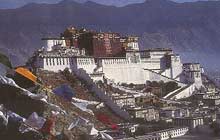
 The impetus for the construction of a palace on Lhasa's Red Hill came from King Songtsen Gampo (608-650) who commissioned it. This was smaller than its 5-square-mile (13-square-km) successor, which was named the Potala ("Pure Land," or "High Heavenly Realm"), after Mount Potalaka in India, the abode of Tibet's patron saint, the Bodhisattva Avalokiteshvara of whom the Dalai Lama is the incarnation.
The impetus for the construction of a palace on Lhasa's Red Hill came from King Songtsen Gampo (608-650) who commissioned it. This was smaller than its 5-square-mile (13-square-km) successor, which was named the Potala ("Pure Land," or "High Heavenly Realm"), after Mount Potalaka in India, the abode of Tibet's patron saint, the Bodhisattva Avalokiteshvara of whom the Dalai Lama is the incarnation.
In 1645, the Fifth Dalai Lama (1645-1693), feeling confined at Drepung Monastery, ordered the construction of a new structure that would accommodate his new role as both a religious and political leader. The Potala was then built as the imposing and self-confident expression of the new theocracy. After the ascension of the Seventh Dalai Lama, who established a summer palace at the Norbulingka, the Potala was used predominantly during winter. Despite this, it always remained the emblematic focus of the Dalai Lama's government. Owing to the security afforded by its elevated position, until the mid-18th century it also served as a military fortress.
The palace contains over a 1000 rooms and is divided into two main sections. The first section, known as the upper "Red Palace" served a religious function, housing the living quarters of the Dalai Lama, the gold-plated tombs of eight previous Dalai Lamas, a library containing religious scriptures and numerous temples, chapels and shrines containing thousands of Buddhist sculptures. The second main section, known as the "White Palace" served a political function, incorporating the offices and living quarters of the Tibetan government, a seminary to train future government officials as well as a printing press. Another minor building, known as the Yellow Building, housed giant thankas, which were hung across the south face of the palace during the last day of the second lunar month.
Directly below these ceremonial areas were quarters for the monks and servants along with two treasuries, one for the Dalai Lama and the other for lesser Lamas and Regents. Lower still lay granaries and storehouses filled with gifts from pilgrims as well as the ever-present yak butter needed to light the Potala's countless votive lamps. At the base of the Potala, carved into rock, were dungeons where prisoners were kept closely guarded.
Measuring 100 meters in height, 400 meters east to west and 350 meters north to south, the inward-sloping stone walls are between three and five meters thick. Copper was poured into the palace foundations, and it is said that so much earth was used in its construction that a lake was made from the pit that was created. When you contemplate the Potala, this massive, beautiful yet forbidding structure, it is evident that its construction was a gigantic undertaking, yet one that has bequeathed to the world one of its most unique architectural treasures.